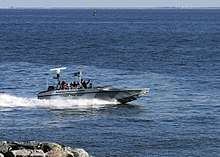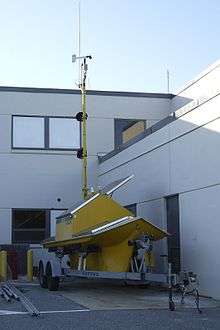Unmanned surface vehicle



Unmanned surface vehicles (USV) or autonomous surface vehicles (ASV) are vehicles that operate on the surface of the water (watercraft) without a crew.
USVs are valuable in oceanography, as they are more capable than moored or drifting weather buoys, but far cheaper than the equivalent weather ships and research vessels,[1] and more flexible than commercial-ship contributions. Wave gliders, in particular, harness wave energy for primary propulsion[2] and, with solar cells to power their electronics, have months of marine persistence[3] for both academic [4][5] and naval applications.[6][7]
Powered USVs are popular for use in hydrographic survey. Using a small USV in parallel to traditional survey vessels as a 'force-multiplier' can double survey coverage and reduce time on-site. This method was used for a survey carried out in the Bering Sea, off Alaska; the ASV Global 'C-Worker 5' autonomous surface vehicle (ASV) collected 2,275 nautical miles of survey, 44% of the project total. This was a first for the survey industry and resulted in a saving of 25 days at sea.[8]
Military applications for USVs include powered seaborne targets and minehunting. Operational USVs with offensive capability include the Israeli Protector USV.[9]
In the future, many unmanned cargo ships are expected to cross the waters.[10]
Saildrone

A saildrone is a type of autonomous watercraft used primarily in oceans for research purposes.[11]
Examples
Specific craft or class:
- OWL-MKII
- B7 USV
- B10 USV
- CAT-Surveyor
- Catarob
- C-Cat 3
- C-Enduro
- C-Worker 4
- C-Worker 5
- C-Worker 6
- C-Worker 7
- C-Worker 8
- C-Sweep
- C-Target 1
- Bluebottle USVs
- Marine targets
- USS Inception MKII
- USV RSV (Marine Tech) [12]
- ACTUV
- USV Bonefish [13][14][15][16][17]
- Coastal Trident
- Fleet-class USV
- Piranha Unmanned Surface Vessel
- Unmanned water vehicle Piraya
- Protector USV
- Proteus
- Scout (autonomous boat)
- Sea Hunter
- Silver Marlin
- SpaceX autonomous spaceport drone ship
- Spartan Scout
- Springer USV [18]
- Vaimos
- U-RANGER* USV [19]
- SimpleSCAN USV
- HarborScout USV
- HarborMaster USV
- WAM-V + Google Trekker
- WAM-V USV
Manufacturers:
- Al Marakeb
- ASV Global (Autonomous Surface Vehicles)
- Marine Tech (RSV)
- Liquid Robotics
- Willow Garage
- SimpleUnmanned, LLC
- Universal Secure Applications OWL-MkII USV
- Unmanned Survey Solutions (USS)
- Marine Tech (RSV)
- Willow Garage
- SimpleUnmanned, LLC
- Marine Advanced Research
- Ocius Technology
- Ocean Alpha
Components:
- MAP Marine Technologies [MAP-Tech]
- UAPS20 Unmanned AutoPilot System
- Marine Tech (RSV)
- Liquid Robotics
- Willow Garage
- Marine Tech (RSV)
- Liquid Robotics
- Willow Garage
- SimpleUnmanned, LLC
Components:
- UAPS20 Unmanned AutoPilot System* ASV Global (Autonomous Surface Vehicles)
- Marine Tech (RSV)
- Liquid Robotics
- Willow Garage
- SimpleUnmanned, LLC
Components:
See also
References
- ↑ Stevens Institute of Technology student USV Archived 2010-08-11 at the Wayback Machine.
- ↑ "Carbon Wave Glider". Retrieved 24 February 2016.
- ↑ "Robot Boats Survive Epic Voyage Across the Pacific — So Far". WIRED. 23 May 2012. Retrieved 24 February 2016.
- ↑ Autonomous Navigation and Obstacle Avoidance of Unmanned Vessels in Simulated Rough Sea States. 18 November 2011. Retrieved 24 February 2016 – via YouTube.
- ↑ "Robotica - An experimental setup for autonomous operation of surface vessels in rough seas - Cambridge Journals Online". Retrieved 24 February 2016.
- ↑ This story was written Amanda D. Stein; Naval Postgraduate School Public Affairs. "NPS Acquires Two USVs, Opens Sea Web Lab for Expanded Undersea Warfare Research". Retrieved 24 February 2016.
- ↑ "Information Dissemination: Eureka! Wave Glider". Retrieved 24 February 2016.
- ↑ Andrew Orthmann (2016-11-22). "Bering Sea ASV Force Multiplier". Hydro-international.com. Retrieved 2018-05-10.
- ↑ "Jerusalem Post, 4 Oct 2009". Archived from the original on 17 September 2011. Retrieved 4 February 2011.
- ↑ "Unmanned cargo ships". Hellenic Shipping News. 17 March 2017. Retrieved 27 May 2018.
- ↑ "Drones at sea: Unmanned vehicles to expand data collection from far-flung locales - National Oceanic and Atmospheric Administration". www.noaa.gov.
- ↑ "Unmanned Surface Vehicle RSV". Marine Tech. 10 January 2017. Retrieved 10 January 2017.
- ↑ SAAB & P.T Lundin Bonefish USV concept at Indodefence 2014. 19 November 2014. Retrieved 24 February 2016 – via YouTube.
- ↑ "Unmanned Surface Vessel". Saab Solutions. 10 February 2016. Retrieved 24 February 2016.
- ↑ "Steering a course for unmanned vessels". InDaily. Retrieved 24 February 2016.
- ↑ "Data". www.aph.gov.au.
- ↑ "Saab Bonefish proceeds apace - News - Shephard". Retrieved 24 February 2016.
- ↑ "Springer USV". Retrieved 24 February 2016.
- ↑ "Unmanned Surface Vehicles". Retrieved 24 February 2016.
External links
| Wikimedia Commons has media related to Unmanned surface vehicles. |